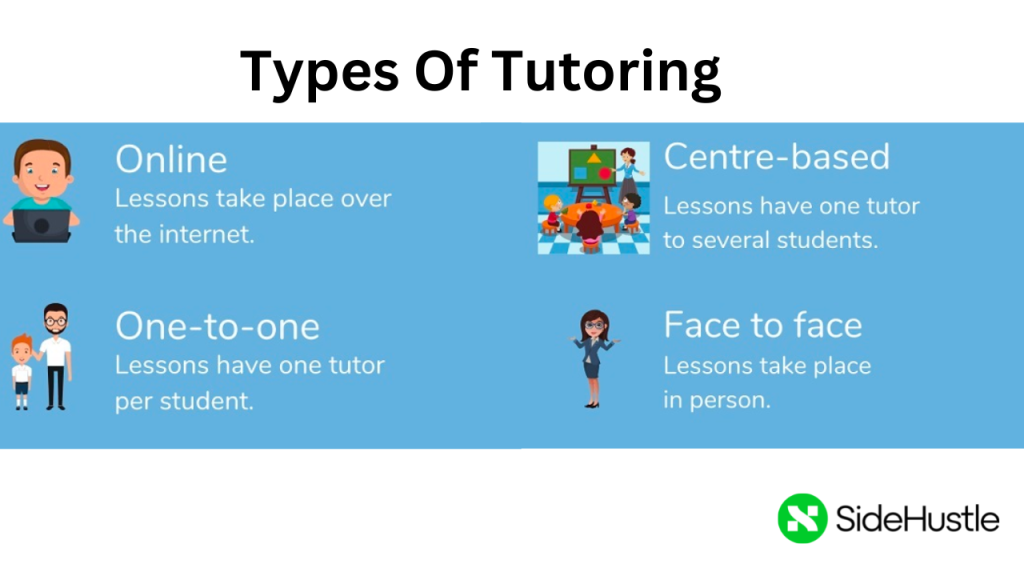Tutoring as a side hustle could be a great way to supplement extra income for both teachers and students. As a tutor, you will help students who need that extra help outside of their school or college and prepare them for exams.

In this article, we will discuss all the steps to starting a tutoring business.
1. Decide Your Niche
Before you can start your tutoring business, you need to decide what will be your specific topic that you will focus on. Many people like to focus on helping students score better on exams such as : SAT , ACT or even MCAT.

The reason you need to have a Niche topic is because, so that once you prepare materials for the tutoring business, you can keep reusing it and can also do group sessions. If you are teaching random things at random times then, you will have hard time managing and it will be hard for you to scale it up.
So, depending on your education and expertise, you will need to find a niche topic. Lately, there is a huge demand for tutors for LSAT ( Law School Exam ) , GRE, MCAT ( Medical School ) and NCLEX ( Nursing certifications) . These pay the highest because most people taking these exams already have a job and make decent money, compare that with SAT, ACT, where parents will be the one paying and there is too many “franchise tutoring” places that guarantee better score.
2. Register Your Company
While many people will want to skip this part. It’s super important that you separate your business and your personal transaction if there is a legal dispute. We recommend registering a simple LLC from sites like RocketLawyer or anything cheap. The name of the LLC doesn’t have to be branded, it could be “Your Name Tutoring LLC”

Once the LLC is registered, you could file something called “DBA” , Doing Business As, with your local clerk and at this point, you can get fancy with the name. The reason we don’t recommend having a brand on the LLC is because, it gives you a flexibility of using that LLC for other side hustles if you choose to and you can change your brand name as well.
Then once you have your company registered, you need to use the incorporated documents to open a bank account where you will receive your payments and make payments for all business related things, so that you can write them off for tax.
3. Branding and Social Media
Once you have your brand name, you will want to get some logos created and few social media pages like Facebook and Instagram.
For the logo, we recommend hiring someone on Fiverr to get a custom logo. Avoid using random images you find on Google Images because first, it might be copyrighted and second, you don’t want to have a generic logo that’s being used by thousands of other people. You want a unique logo that you are proud of. If fiverr is too expensive for you, then we recommend using Tools like Canva, where you can drag and drop tool to create your own logo for free.
Once you have the logo, use that to create your Facebook and Instagram Pages. On this pages, you should post useful content 2-3 times a week such as exam prep tips for your specific niche or any infographic that could help people prepare for their exam. The more useful your content, the more it will get “SAVED” and “SHARED”, which will help it get viral to more people. On your bio of your social media, add things like “DM for Tutoring” or some sort of contact link or phone number so people can reach out to you.
4. Set Your Pricing

Before you start looking for customers, you should come up with pricing for your tutoring services. You could charge people “X” of fee per month. If the tutoring is 1 on 1 then the fee should be x10 more because you will have to dedicate the time to just that one student but if it’s a group sessions then price could be little affordable.
Don’t make your prices too low, keep them relatively high since as a individual tutor, it will be hard for you to scale the business since you are the only one doing the tutoring, it’s best if your prices are high so you can make more money with smaller group of students.
5. Finding Customers
Finding customers for your tutoring business could be the hardest thing but it doesn’t have to be that difficult if you are doing it right. Once you have few customers, you can get the word out from them, but initially, you will have to hustle to find your first 10 customers.

Here are some ideas on how to you find customers:
- Start a “Dallas “x” Help” Group on Facebook
This help group is focused on a specific location and for your niche. For example, “New York SAT help Group” This is going to attract a lot of people , and you could do free sessions every twice a week to attract more people as leads. - Pay a student to pass out flyers in Universities or HighSchool
- Post on Craigslist about your offer
- Join Sub-Reddits about your Niche
- Network at Meetup.com for your specific niche
➡️ See other Side Hustle Ideas
Frequently Asked Questions
How do you become a tutor side hustle?
- Decide a niche
- Register your company
- Create a Brand & Pricing
- List your services for sale
How much should I charge for 1 hour of tutoring?
Most tutors charge $60-$80 per hour for 1 hour a group tutoring. If you are doing a one on one tutoring, charge about $100-$200 per hour
What kind of tutors make the most money?
LSAT Tutors ( $56,000 to $130,000 Yearly)
GRE Tutors ( $52,000 to $66,000 Yearly)
SAT/ACT Tutors ( $43,000 to $55,000 Yearly)
Is it worth becoming a tutor?
Tutoring is a very demanding side hustle because it will require you to be mentally active all the time while teaching, grading and answering students questions. This is not an easy side hustle where you make passive income and it’s limited by the # of hours you can work.
How long should tutoring sessions be?
Tutoring sessions should be about 25 minutes to 45 minutes because it’s been proven that longer sessions don’t necessarily help the students learn better and causes fatigue for both students and tutor.


